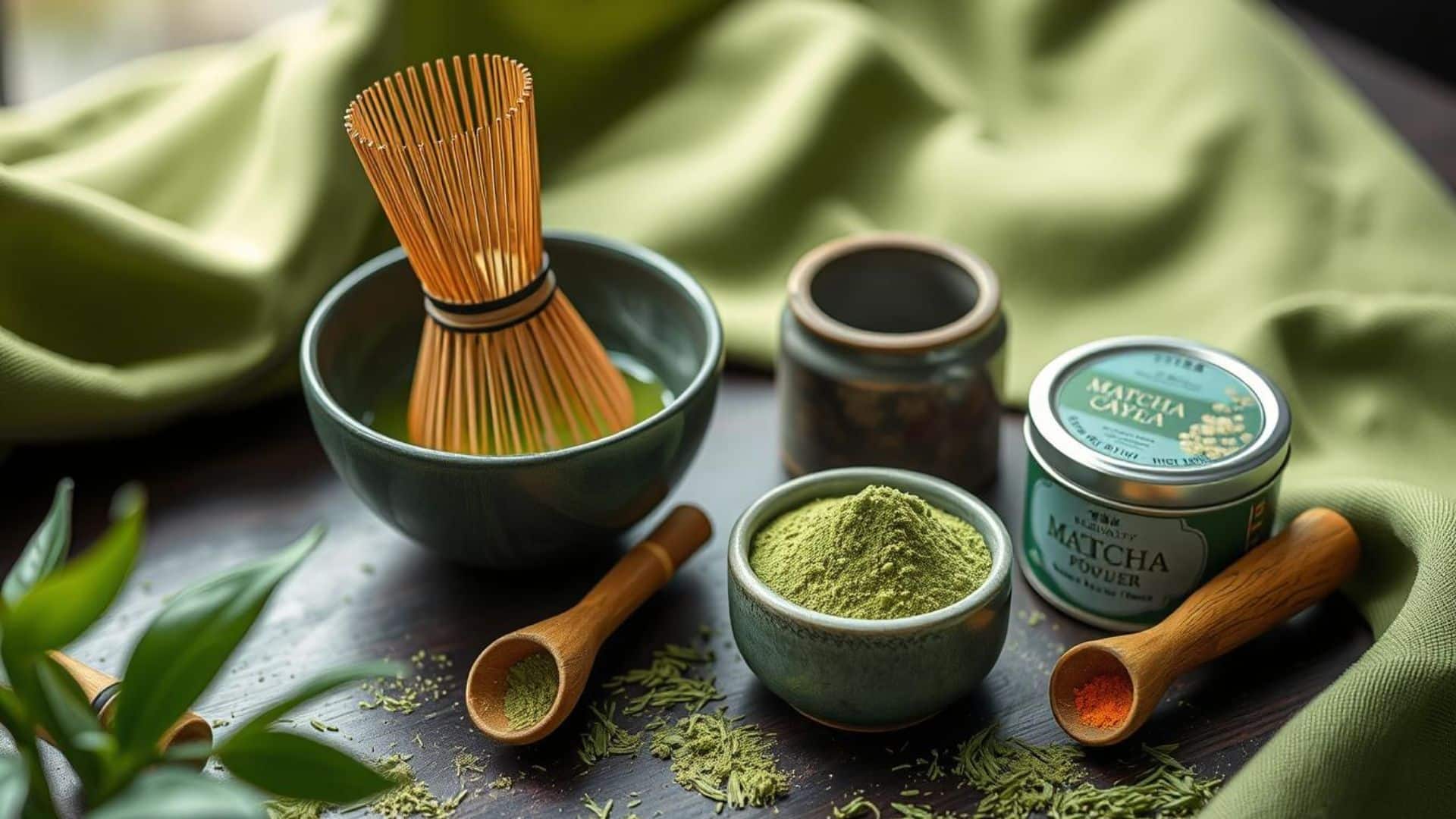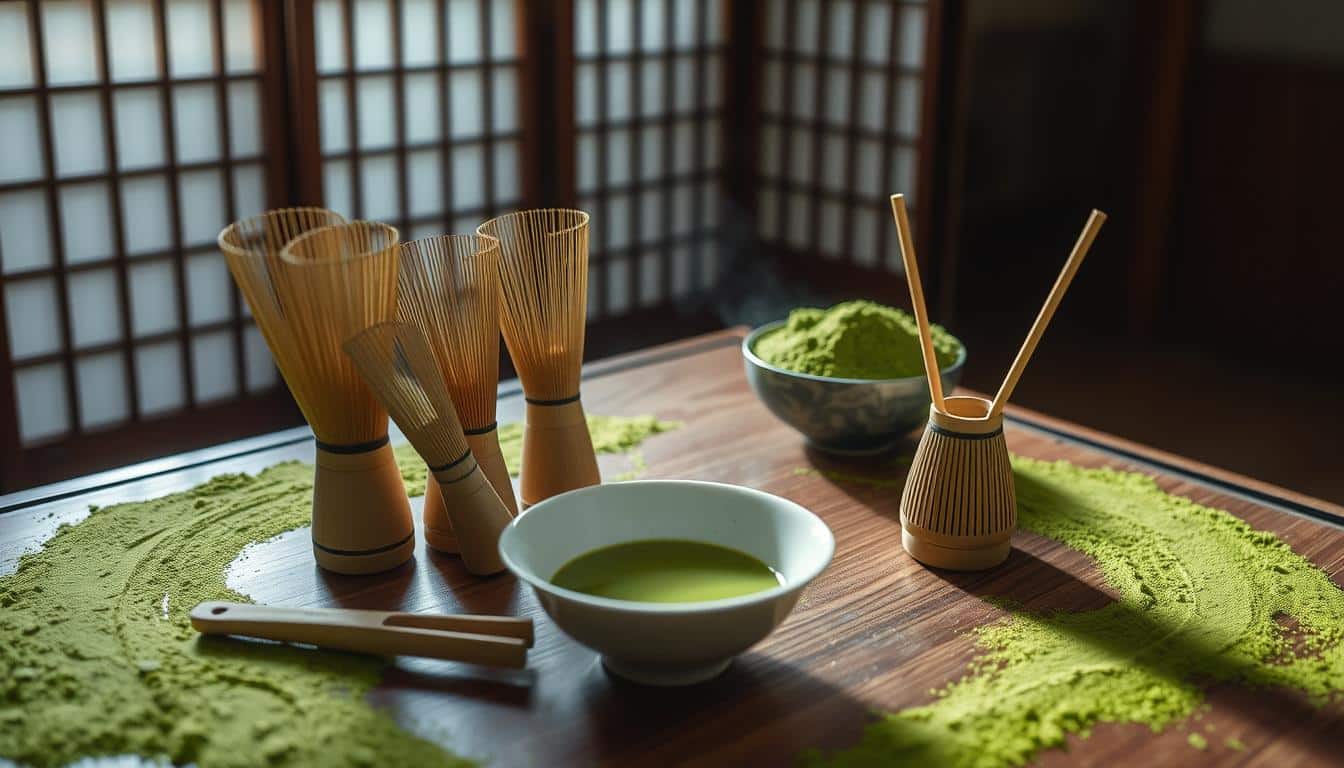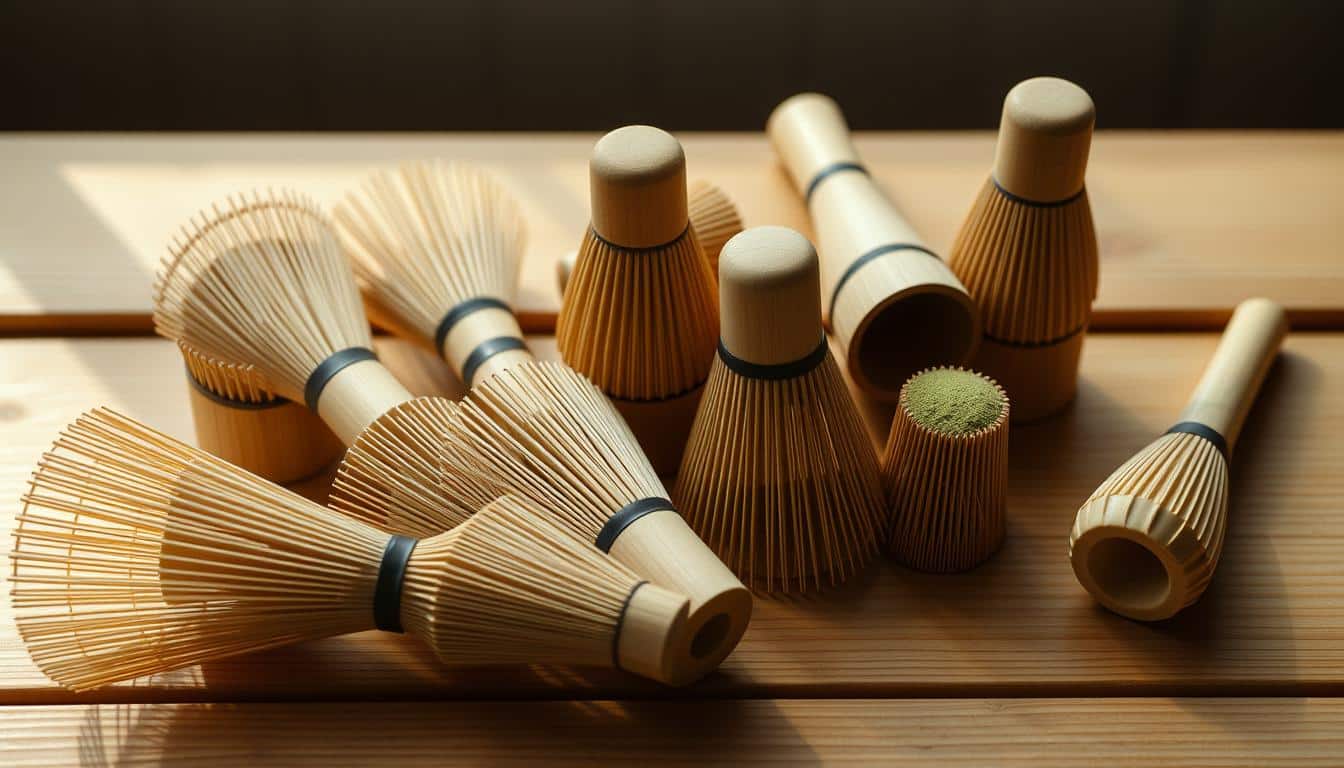Did you know the traditional Japanese chasen, a bamboo whisk, has been made the same way for over 600 years? It has dozens of springy tines that mix matcha into a perfect froth. Unlike metal whisks, the bamboo chasen keeps your matcha clump-free and doesn’t scratch your bowl.
Using a quality matcha brush is key for anyone who takes their matcha seriously. The chasen’s design makes a smooth, frothy consistency that metal whisks can’t match. By learning techniques like the W-Technique and proper care, you can improve your matcha experience at home. The bamboo chasen, made with care, adds both function and beauty to your tea-making.
Key Takeaways
- A traditional bamboo matcha whisk, called a chasen, is essential for making matcha at home.
- The chasen’s design allows for the matcha to be whisked into a frothy suspension, unlike metal whisks.
- Proper techniques, such as the W-Technique, ensure the perfect blend and texture of your matcha.
- Handcrafted bamboo chasens are both functional and artistic, contributing to a high-quality matcha experience.
- Careful maintenance, including rinsing with warm water and proper drying, extends the life of your matcha brush.
Why a Matcha Brush is Essential for Perfect Matcha
A matcha brush, or chasen, is key for making traditional matcha. It’s made to make the tea smooth and frothy. This tool makes the matcha experience special.
Understanding the Chasen
The chasen is made from bamboo and has a long history. It was first used in the 1300s. Masters in Takayama make these tools, turning them into art.
There are many types of chasen, like the 80-tine and 100-tine ones. The shin shape, with about 64 tines, is very popular. It’s used by big tea schools like Urasenke and Omotesenke.
Chasens come from three types of bamboo. Each type looks and works differently. The soot-colored bamboo whisk is rare and very special.
It takes eight steps to make a chasen. This turns simple bamboo into a matcha brush. It’s both beautiful and useful.
Benefits Over Traditional Whisks
Bamboo whisks beat metal ones in many ways. They have many prongs that mix matcha well. This makes sure the tea is smooth and even.
Metal whisks don’t mix as well and can scratch your bowls. A special chasen makes foam fast, giving you a creamy matcha. Chasens are made by hand in Takayama, making them art and not just tools.
With care, a chasen can last for years. It’s a key part of your tea ceremony.
History and Significance of the Chasen
The chasen is a key part of Japanese tea ceremonies. It has a long history, dating back almost 500 years. The Tanimura family from Takayama village in Nara Prefecture has kept this tradition alive.
Takayama village is famous for making top-quality chasen by hand. No machines or chemicals are used. For over five centuries, this village has been a center for chasen making.
There are about 100 types of chasen for different tea schools. This shows how important this tool is in Japanese tea ceremonies.
Making a chasen is a complex task that needs a lot of skill. From one piece of bamboo, only three to four chasen can be made. The bamboo is split into 16 parts and shaped into tines.
Master artisans like Master Tango Tanimura make each chasen by hand. They shave the tines, round their ends, and add colored thread. This makes each chasen unique.
Even though China makes most chasen, handcrafted ones from artisans like Master Tanimura are sought after. They can take up to a year to make. These whisks are not just tools but symbols of Japanese tea culture.
Traditional Japanese tea accessories are key to the tea ceremony. The chasen is at the center of this ritual.
| Chasen Type | Features | Common Use |
|---|---|---|
| Shin Chasen | Roughly 64 tines | Suitable for both usucha (thin tea) and koicha (thick tea) |
| Oaraho | Lengthened tines | Preferred by specific tea schools |
| Tenmokudate | Shorter handle | Used for particular tea ceremonies |
| Kankyuu-an | Unique configuration of tines | Used by specialized tea schools |
Choosing the Right Matcha Brush
Finding the right matcha brush is key to a perfect cup of matcha tea. A good matcha brush makes tea time better and helps your tea gear last longer. Let’s look at what matters, like the material and how it’s made.
Material Matters: Bamboo vs. Metal
The material of your matcha brush is very important. Bamboo is often used because it’s flexible and strong. Bamboo brushes from Japan’s Nara prefecture are known for their top quality.
Metal brushes are strong but don’t bend like bamboo. This bend is important for making the right foam in matcha.
Bamboo brushes grow naturally, without chemicals. This makes your tea safer and more real. Good bamboo makes the brush last longer and work better. Metal brushes might not be as gentle with the fine matcha powder.
Handcrafted vs. Mass-Produced
How a matcha brush is made is also key. Handmade brushes from Takayama have a long history. They go through eight steps, from picking bamboo to shaping the tines. Each one is special, showing the maker’s skill.
Mass-made brushes use machines and are cheaper but not as good. Handmade ones last longer and work better. Brushes with 80 to 120 tines make the best foam. Chasens from Takayama are famous for their skill.
| Feature | Bamboo Matcha Brush | Metal Matcha Brush | Handcrafted | Mass-Produced |
|---|---|---|---|---|
| Material | Flexible, durable | Rigid, durable | High-quality, organic bamboo | Various, often machine-influenced |
| Performance | Ideal foam, authentic texture | Less flexible | Unique, artisanal quality | Uniform, less effective |
| Durability | Up to 12 months or more with care | Long-lasting | Extended lifespan with upkeep | Moderate lifespan |
| Production | Traditional practices, chemical-free | Mass production techniques | Handmade by skilled artisans | Machine-made |
Choosing a handcrafted bamboo matcha brush supports a long tradition. It also makes your matcha better. These traditional tea tools, made with care, will make your tea time special.
How to Use a Matcha Brush for the Perfect Blend
Creating the perfect bowl of matcha needs the right tools. The matcha bamboo whisk, or chasen, is key. It has 80 to 100 small bristles. Here’s how to blend your matcha perfectly.

The W-Technique
The W-Technique is key for making matcha. Start by soaking your chasen in warm water. This makes the bristles flexible and less likely to break.
Then, put your whisk in hot water for a minute. This warms the whisk and the bowl. It gets ready for making matcha.
Next, add matcha powder to the bowl with a bamboo spoon, or chashaku. Pour in hot water heated to 175°F (80°C). Now, whisk in a zigzag motion like the letter “W.” Use wrist movements, not your whole arm. Aim for 20 to 40 seconds of whisking.
Ensuring No Clumps with Proper Whisking
Good whisking adds air and prevents clumps. A smooth texture makes the matcha better. Make sure your matcha powder is sifted before whisking.
Using high-quality chasens from Takayama village helps. These tools are made with great care. They lead to a better matcha blend. Always wash your chasen with water after use. Avoid harsh soaps or scrubbing sponges.
For more tips on using a matcha whisk, check out this guide.
Alternative Tools for On-the-Go Matcha Preparation
There are now modern ways to make tea that are easy and convenient. These matcha preparation tools are great for people who are always moving. They don’t replace the traditional chasen, but they offer a good solution for those in a hurry.
Milk Frother
A handheld frother is often used for frothing milk. It can also be used as a matcha tool when you don’t have a chasen. But, it’s important to know that electric frothers can’t fully break up matcha clumps.
Even so, a milk frother can mix the tea well. But it’s not as precise as using a bamboo whisk.
Shaker Cups
Shaker cups are a popular choice for making matcha on the go. They are easy to use and can dissolve matcha powder well. Just put the matcha, water in the cup, close it, and shake for 30 seconds to mix well.
But be careful with warm water. Shaking it can make it too hot and might spill.
Shaker cups are not just for matcha. They’re also great for making matcha lattes and smoothies. Many people use them when they’re in a hurry or traveling.
| Tool | Advantages | Limitations |
|---|---|---|
| Milk Frother | Easy to use, portable | May leave clumps, less precise |
| Shaker Cups | Portable, effective, versatile | Potential for heat buildup, less traditional |
Using these matcha preparation tools makes it easy to enjoy matcha without needing a chasen. Whether you choose a milk frother or a shaker cup, there’s a tool for everyone’s busy life.
Caring for Your Matcha Brush to Ensure Longevity
Proper care for your matcha brush is key to a great matcha experience. Learn how to clean and store your chasen right. This will keep your ceremonial matcha whisks in top shape for making perfect frothy drinks.
Cleaning Tips
Cleaning your chasen well is important. Rinse it with warm water right after each use. Don’t use soap or harsh cleaners as they can harm the bamboo.
Swish the whisk in warm water until all matcha is gone. Be careful not to rub the tines on the bowl’s bottom. This can break them.

Try seasoning your whisk by soaking it in hot water for 30 seconds before using it. This makes the tines softer and less likely to break. With this care, your chasen can last about two years.
Storage Solutions
Storing your chasen right is key to its longevity. Let it dry fully after cleaning. A damp whisk can grow mold and affect the taste of your matcha.
Use a kusenaoshi (whisk holder) for storage. It keeps the tines straight and allows air to flow, preventing moisture build-up. This is important for all types of whisks, whether made in Japan or China.
For more on matcha and other traditional drinks, check out this comparison of yerba mate and matcha.
| Care Step | Recommendation |
|---|---|
| Cleaning | Rinse with warm water, avoid soap, and gentle swish |
| Seasoning | Soak in hot water for 30 seconds before use |
| Drying | Allow to air dry completely |
| Storage | Use a whisk holder for shape and air circulation |
Common Mistakes When Using a Matcha Brush
Are you new to matcha? Using a matcha brush right is key for a great frothy drink. But, some mistakes can ruin your matcha. Let’s fix these issues to improve your matcha skills.
One big mistake is whisking with cold prongs. Make sure your matcha brush is warmed up by soaking it in warm water before use. This makes the prongs soft and helps avoid breakage, making whisking easier.
Another mistake is applying too much pressure. Use gentle, quick wrist movements in a “W” shape to mix the matcha. This creates the froth you want. Too much force can damage the brush and mess up the tea’s texture.
Keeping your bamboo whisk in good shape is also key. Wrong cleaning and storage can make your matcha brush last less time. Clean the bristles well with warm water after each use to get rid of all matcha. Don’t use soap as it can harm the bamboo.
Store your chasen upright to keep its shape, on a whisk holder called a chasen kusenaoshi. This keeps the prongs straight for better whisking. Also, keep the brush in a dry place to stop mold from growing; bamboo likes good air flow.
Finally, watch the water temperature. The best water for whisking matcha is about 175°F (80°C). Hot water can burn the matcha leaves and lessen their taste. Let boiling water cool for 5 minutes before whisking for the best flavor.
Steer clear of these mistakes and take good care of your bamboo whisk for a great matcha every time. Enjoy whisking!
Enhancing Your Tea Ceremony with Traditional Japanese Tea Accessories
Using traditional Japanese tea accessories can make your matcha preparation special. The chasen is key, but other tools also play big roles. They help make your tea ritual authentic and meaningful.
Other Essential Tools
There are more tools you need for a full tea setup, besides the chasen. The chashaku, a bamboo scoop, is vital for measuring matcha right. It costs $2.84 USD and is reviewed by one user.
For keeping your chasen in shape, get a whisk stand for $7.40 USD with one review. The ceremonial matcha bowls come in designs like Deep Ocean and Red Soul. They cost $46.54 USD and are loved by many users.
Setting Up a Traditional Ceremony at Home
To set up a real tea ceremony at home, start with a calm space. This lets you enjoy your tea fully. Use 50ml of water for thick matcha and 70ml for thin matcha.
Whisk thick matcha in a slow circle and thin matcha with a fast “W” motion. A Ceremonial Starter Kit ($106.83 USD with one review) makes preparing easy.
Using these traditional tools and practices does more than improve the taste. It creates a complete experience filled with history. By following this ritual, you make each sip a moment of peace. Let these tools guide you deeper into the world of matcha.


